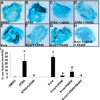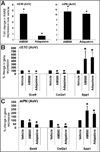Increased dietary intake of vitamin A promotes aortic valve calcification in vivo
- PMID: 23202364
- PMCID: PMC3557503
- DOI: 10.1161/ATVBAHA.112.300388
Increased dietary intake of vitamin A promotes aortic valve calcification in vivo
Abstract
Objective: Calcific aortic valve disease (CAVD) is a major public health problem with no effective treatment available other than surgery. We previously showed that mature heart valves calcify in response to retinoic acid (RA) treatment through downregulation of the SRY transcription factor Sox9. In this study, we investigated the effects of excess vitamin A and its metabolite RA on heart valve structure and function in vivo and examined the molecular mechanisms of RA signaling during the calcification process in vitro.
Methods and results: Using a combination of approaches, we defined calcific aortic valve disease pathogenesis in mice fed 200 IU/g and 20 IU/g of retinyl palmitate for 12 months at molecular, cellular, and functional levels. We show that mice fed excess vitamin A develop aortic valve stenosis and leaflet calcification associated with increased expression of osteogenic genes and decreased expression of cartilaginous markers. Using a pharmacological approach, we show that RA-mediated Sox9 repression and calcification is regulated by classical RA signaling and requires both RA and retinoid X receptors.
Conclusions: Our studies demonstrate that excess vitamin A dietary intake promotes heart valve calcification in vivo. Therefore suggesting that hypervitaminosis A could serve as a new risk factor of calcific aortic valve disease in the human population.
Conflict of interest statement
The authors of this paper have no conflicts of interest.
Figures





Similar articles
-
Reduced sox9 function promotes heart valve calcification phenotypes in vivo.Circ Res. 2010 Mar 5;106(4):712-9. doi: 10.1161/CIRCRESAHA.109.213702. Epub 2010 Jan 7. Circ Res. 2010. PMID: 20056916 Free PMC article.
-
Valve Endothelial Cell-Derived Tgfβ1 Signaling Promotes Nuclear Localization of Sox9 in Interstitial Cells Associated With Attenuated Calcification.Arterioscler Thromb Vasc Biol. 2016 Feb;36(2):328-38. doi: 10.1161/ATVBAHA.115.306091. Epub 2015 Dec 3. Arterioscler Thromb Vasc Biol. 2016. PMID: 26634652 Free PMC article.
-
NFκB (Nuclear Factor κ-Light-Chain Enhancer of Activated B Cells) Activity Regulates Cell-Type-Specific and Context-Specific Susceptibility to Calcification in the Aortic Valve.Arterioscler Thromb Vasc Biol. 2020 Mar;40(3):638-655. doi: 10.1161/ATVBAHA.119.313248. Epub 2020 Jan 2. Arterioscler Thromb Vasc Biol. 2020. PMID: 31893948 Free PMC article.
-
Conserved transcriptional regulatory mechanisms in aortic valve development and disease.Arterioscler Thromb Vasc Biol. 2014 Apr;34(4):737-41. doi: 10.1161/ATVBAHA.113.302071. Arterioscler Thromb Vasc Biol. 2014. PMID: 24665126 Free PMC article. Review.
-
Molecular and cellular aspects of calcific aortic valve disease.Circ Res. 2013 Jul 5;113(2):198-208. doi: 10.1161/CIRCRESAHA.113.300155. Circ Res. 2013. PMID: 23833294 Free PMC article. Review.
Cited by
-
Growth and maturation of heart valves leads to changes in endothelial cell distribution, impaired function, decreased metabolism and reduced cell proliferation.J Mol Cell Cardiol. 2016 Nov;100:72-82. doi: 10.1016/j.yjmcc.2016.10.006. Epub 2016 Oct 15. J Mol Cell Cardiol. 2016. PMID: 27756541 Free PMC article.
-
Calcific Aortic Valve Disease: a Developmental Biology Perspective.Curr Cardiol Rep. 2018 Mar 8;20(4):21. doi: 10.1007/s11886-018-0968-9. Curr Cardiol Rep. 2018. PMID: 29520694 Free PMC article. Review.
-
Retinoids Repress Human Cardiovascular Cell Calcification With Evidence for Distinct Selective Retinoid Modulator Effects.Arterioscler Thromb Vasc Biol. 2020 Mar;40(3):656-669. doi: 10.1161/ATVBAHA.119.313366. Epub 2019 Dec 19. Arterioscler Thromb Vasc Biol. 2020. PMID: 31852220 Free PMC article.
-
MG 53 Protein Protects Aortic Valve Interstitial Cells From Membrane Injury and Fibrocalcific Remodeling.J Am Heart Assoc. 2019 Feb 19;8(4):e009960. doi: 10.1161/JAHA.118.009960. J Am Heart Assoc. 2019. PMID: 30741589 Free PMC article.
-
Vitamin A decreases the anabolic bone response to mechanical loading by suppressing bone formation.FASEB J. 2019 Apr;33(4):5237-5247. doi: 10.1096/fj.201802040R. Epub 2019 Jan 22. FASEB J. 2019. PMID: 30668919 Free PMC article.
References
-
- Rajamannan NM, Evans FJ, Aikawa E, Grande-Allen KJ, Demer LL, Heistad DD, Simmons CA, Masters KS, Mathieu P, O'Brien KD, Schoen FJ, Towler DA, Yoganathan AP, Otto CM. Calcific aortic valve disease: Not simply a degenerative process: A review and agenda for research from the national heart and lung and blood institute aortic stenosis working group. Executive summary: Calcific aortic valve disease-2011 update. Circulation. 2011;124:1783–1791. - PMC - PubMed
-
- Lincoln J, Yutzey KE. Molecular and developmental mechanisms of congenital heart valve disease. Birth defects research. Part A, Clinical and molecular teratology. 2011;91:526–534. - PubMed
-
- Wirrig EE, Snarr BS, Chintalapudi MR, O'Neal JL, Phelps AL, Barth JL, Fresco VM, Kern CB, Mjaatvedt CH, Toole BP, Hoffman S, Trusk TC, Argraves WS, Wessels A. Cartilage link protein 1 (crtl1), an extracellular matrix component playing an important role in heart development. Developmental biology. 2007;310:291–303. - PMC - PubMed
Publication types
MeSH terms
Substances
Grants and funding
LinkOut - more resources
Full Text Sources
Other Literature Sources
Medical
Research Materials

